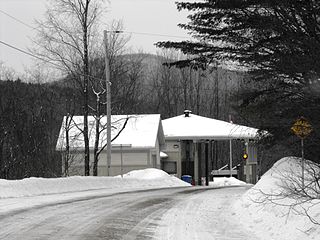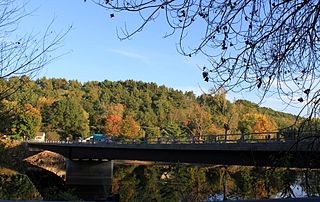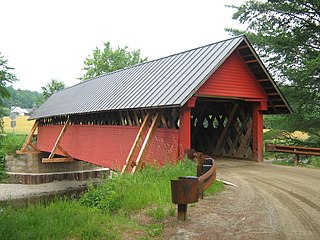The Central Vermont Railway was a railroad that operated in the U.S. states of Connecticut, Massachusetts, New Hampshire, New York, and Vermont, as well as the Canadian province of Quebec.

The Portland & Ogdensburg Railroad was a railroad planned to connect Portland, Maine to Ogdensburg, New York. The plan failed, and in 1880 the Vermont section was reorganized and leased by the Boston & Lowell Railroad. In 1886, the Maine and New Hampshire section was reorganized as the Portland & Ogdensburg Railway. That part was leased to the Maine Central Railroad in 1888, and in 1912 the Maine Central leased the eastern part of the Vermont section from the Boston & Maine Railroad, the successor to the B&L.
The St. Johnsbury and Lamoille County Railroad (StJ&LC) was a railroad located in northern Vermont. It provided service to rural parts of the state for over a century, until track deterioration and flood damage made the line unusable and uneconomical to repair, which forced the line to close in 1995. Vermont is in the process of converting the roughly 96-mile route from St. Johnsbury to Swanton into a rail trail, known as the Lamoille Valley Rail Trail. Once completed it will be the longest rail trail in New England.

The Church Street Covered Bridge, also called the Village Covered Bridge, is a wooden covered bridge that crosses the North Branch of the Lamoille River in Waterville, Vermont off State Route 109. Built in the late 19th century, it is one of five covered bridges in a space of about five miles that cross the North Branch Lamoille. It was listed on the National Register of Historic Places in 1974.

The Power House Covered Bridge, also known as the School Street Covered Bridge, is a covered bridge from 1872 that crosses the Gihon River off State Route 100C in Johnson, Vermont, US. It was listed on the National Register of Historic Places in 1974. The bridge's name is from a now obsolete hydroelectric generating station just upstream from it. The bridge is of Queen post truss design by an unknown builder.

The Mill Covered Bridge is a wooden covered bridge that crosses the North Branch Lamoille River on Back Road in Belvidere, Vermont. Built about 1890, it is one of two surviving covered bridges in the rural community. It was listed on the National Register of Historic Places in 1974.

The Morgan Covered Bridge, also known as the Upper Covered Bridge is a wooden covered bridge that crosses the North Branch Lamoille River in Belvidere, Vermont on Morgan Bridge Road. Built about 1887, it is one of the two covered bridges in Belvidere, and one of five in a five-mile span that all cross the same river. It was listed on the National Register of Historic Places in 1974.

The East Richford–Glen Sutton Border Crossing connects the towns of Sutton, Quebec and Richford, Vermont on the Canada–US border. During the early 20th century, this scenic road was a major east–west thoroughfare. In 1936, the United States built a large border station that is still in use today, and is listed on the National Register of Historic Places. By coincidence, the actual border crossing is on the Missisquoi River Bridge, built in 1929 and also listed on the US National Register. The original bridge, built in 1926, was destroyed only a year later in the Great Vermont Flood of 1927. The US and the Canadian stations are open daily from 8:00am to 4:00pm.

The Lamoille River Route 15-A Bridge is a modern steel-and-concrete structure, built in 2013 to carry Vermont Route 15A over the Lamoille River east of Morrisville, Vermont, United States. It was built to replace a metal truss bridge erected there in 1928. The old bridge, of Pratt through truss design, was listed on the National Register of Historic Places in 1991, and was dismantled in 2007.

The Fisher Covered Railroad Bridge is a covered bridge in Wolcott, Vermont. Built in 1908, it originally carried the St. Johnsbury and Lamoille County Railroad line over the Lamoille River. Now closed, it was the last covered bridge in Vermont to carry railroad traffic, and is a rare surviving example in the state of a double Town lattice truss. It was listed on the National Register of Historic Places in 1974.
The Morrisville Depot located at 10 Depot Street in Morrisville, Vermont, is a decommissioned historic train station. Built in 1872 to serve the Portland and Ogdensburg Railway, the depot was known as the most important train station for the Vermont lumber industry, for its decorative architectural ornament, and for housing the headquarters of the St. Johnsbury and Lamoille County Railroad from 1959 to the early 1970s. It was subsequently converted into a restaurant. The Morrisville Depot was added to the National Register of Historic Places in 1982 as building #15 in the Morrisville Historic District.

Bridge 12 is a historic Parker through truss bridge, carrying Boston Post Road across the Missisquoi River in Enosburg, Vermont. Built in 1929 in the wake of Vermont's devastating 1927 floods, it is one a shrinking number of surviving truss bridges on the river. It was listed on the National Register of Historic Places in 2007.

The Railroad Street Bridge is a historic Pratt through truss bridge, carrying Railroad Street across the Lamoille River in Johnson, Vermont. It was built in 1928, after the state's devastating 1927 floods, and is one of its few surviving Pratt through truss bridges. It was listed on the National Register of Historic Places in 2007 as Bridge 6.

The Jaynes Covered Bridge is a historic covered bridge, carrying Codding Hollow Road across the North Branch Lamoille River in Waterville, Vermont. Built in 1877, it is one of three 19th-century covered bridges in the town, and one of five to span the North Branch Lamoille in a five-mile span. It was listed on the National Register of Historic Places in 1974.

The Jeffersonville Bridge is a steel girder bridge carrying Vermont Route 108 across the Lamoille River, just north of the village of Jeffersonville, Vermont. It was built in 2014, replacing a Parker through truss bridge built in 1931; the latter bridge was listed on the National Register of Historic Places in 1991.

The Johnson Railroad Depot was a historic former railroad station on Railroad Street in Johnson, Vermont. Built in 1887, it was an excellent example of Victorian railroad architecture, serving as a gateway for the town's industrial products to markets nationwide. Converted to commercial use after rail service was discontinued on the line, it was listed on the National Register of Historic Places in 1980. It has since been demolished; a modern building stands where it used to.

The West Milton Bridge is a steel girder bridge carrying Bear Trap Road across the Lamoille River in Milton, Vermont, United States. It was built as a replacement for a 1902 Pennsylvania truss bridge, which was relocated to the site of the Swanton Covered Railroad Bridge, and is listed on the National Register of Historic Places.

The Greensboro Depot is a historic railroad station on Main Street in the village of Greensboro Bend, Vermont. Built about 1872 by the Portland and Ogdensburg Railroad, it is a well-preserved example of that railroad's early station designs, and a reminder of the village's historic association with the railroad. It was listed on the National Register of Historic Places in 1975.

The River Road Covered Bridge was a historic covered bridge, carrying Veilleux Road across the Missisquoi River in Troy, Vermont. Built in 1910, the Town lattice truss was the only surviving covered bridge in Troy from the historic period of covered bridge construction when it burned on February 6, 2021. It also exhibited some distinctive variations in construction from more typical Town lattices. It was listed on the National Register of Historic Places in 1974.



















